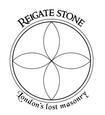Definitions
Common stone deterioration terms
The following definitions are taken from the ICOMOS Illustrated glossary on stone deterioration patterns. They are common terms, which have been applied here to help describe Reigate Stone conditions.
| Alveolisation | Formation, on the stone surface, of cavities (alveoles) which may be interconnected and may have variable shapes and sizes (generally centimetric, sometimes metric). |
|---|---|
| Black crust | Kind of crust developing generally on areas protected against direct rainfall or water runoff in urban environment. Black crusts usually adhere firmly to the substrate. |
| Blistering | Separated, air filled, raised hemispherical elevations on the face of stone resulting from the detachment of an outer stone layer. This detachment is not related to the stone structure. |
| Craquele | Network of minor cracks also called crack network. |
| Coving | Erosion feature consisting in a single alveole developing from the edge of the stone block. |
| Crust | Generally coherent accumulation of materials on the surface. A crust may include exogenic deposits in combination with materials derived from the stone. |
| Encrustation | A coherent layer, which is always adherent to the substrate. |
| Erosion | Loss of original surface, leading to smoothed shapes. |
| Film | Thin covering or coating layer generally of organic nature, generally homogeneous, follows the stone surface. A film may be opaque or translucent. |
| Flaking | Scaling in thin flat or curved scales of submillimetric to millimetric thickness, organized as fish scales. |
| Granular disintegration | Produces debris referred to as a rock meal and can often be seen accumulating at the foot of wall actively deteriorating. If the stone surface forms a cavity (coving), the detached material may accumulate on the lower part of the cavity. The grain size of the stone determines the size of the resulting detached material. |
| Peeling | Shedding, coming off, or partial detachment of a superficial layer (thickness : submillimetric to millimetric) having the aspect of a film or coating which has been applied on the stone surface. |
| Powdering | Granular disintegration of finely grained stones. |
| Salt crust | Crust composed of soluble salts, which develop in the presence of high salt levels, and form from wetting and drying cycles. |
| Scaling | Detachment of stone as a scale or a stack of scales, not following any stone structure and detaching like fish scales or parallel to the stone surface. |
| Spalling | Scaling in which the interface with the sound part of the stone is parallel to the stone surface. |
| Subflorescence | Poorly adhesive soluble salts, commonly white, located under the stone surface. |
Other terms
The following is a list of terms which are not fully explained in the ICOMOS glossary, or where we felt a more nuanced definition was necessary in relation to understanding Reigate Stone. The definitions listed here are our own and are intended to clarify usage of these terms in the context of the research presented on this website.
Reigate Stone mineralogy
| Calcite | The most common form of calcium carbonate (CaCO3). The main component of limestone, but can be present in other stone types, particularly if bioclasts (fragments of biological origin) occur, from which it dissolves and recrystallises. In Reigate Stone it is present in highly variable amounts, with high content forming a stong cement and characteristic whitening. |
|---|---|
| Glauconite | An iron and potassium rich phyllosilicate (sheet silicate) with blue-green colour. Can refer to different morpholoigical and mineral occurences depending on context. In Reigate Stone it is connected to the occurence of smectite (swelling clay), with different stages of glauconization (i.e. maturity) responsible for different clay contents and shades of green in variations of the stone. |
| Opal-CT | Precipitated crystalline silica which forms both a highly micro-porous matrix and functions as the main cement in Reigate Stone. Without additional pore-filling calcite the cementation is weak. CT stands for Cristabolite/Tridymite, with lepispheric cristabolite occuring in Reigate Stone and forming connected spheroids of approx. 20 μm diameter. |
Reigate Stone conservation
| Conservation/ Architectural conservation | Initially a mid-19th century movement opposed to stylistic restoration. Now frequently used as an umbrella-term for care of historic (built) environment, which is accepted to include a wide range of remedial action, including targeted restoration, repair, consolidation, and environmental control. Practical framework sometimes described as Conservation-Restoration. |
|---|---|
| Decay | Physical change in response to environmental mechanisms. Decay can result in deterioration, through loss of strength or undesirable aesthetic changes. Decay can, however, also be considered to add value to heritage, typically be emphasising age or relationship to the environment. |
| Deterioration | A loss of quality or cultural value. Occurs when decay crosses aesthetic or functional thresholds. Can manifest without physical change as thresholds fluctuate according to context. |
|
Problem Stone |
Used until recently by Historic England to describe a group of building stones (including Reigate Stone) which were responsible for a disproportionate amount of conservation effort. Dropped in favour of hard to treat stone, due to concerns over negative associations. Proposal in this thesis to consider using vulnerable masonry as more inclusive of interrelated processes affecting decay. |
| Resilience | The property of masonry (or other elements of the historic built environment) to withstand deterioration, i.e. retain value despite physical change. This term is increasingly favoured to resistance as a way of describing a favourable quality to achieve through conservation. |
| Resistance | The property of material (e.g. stone) to withstand decay, i.e. resist physical change. |



